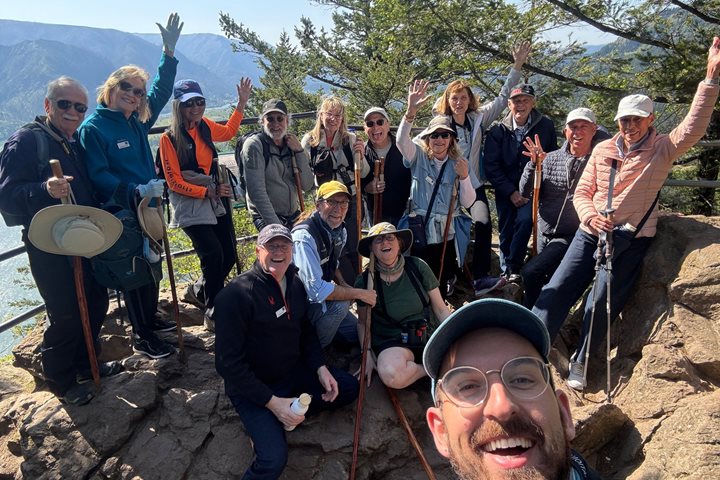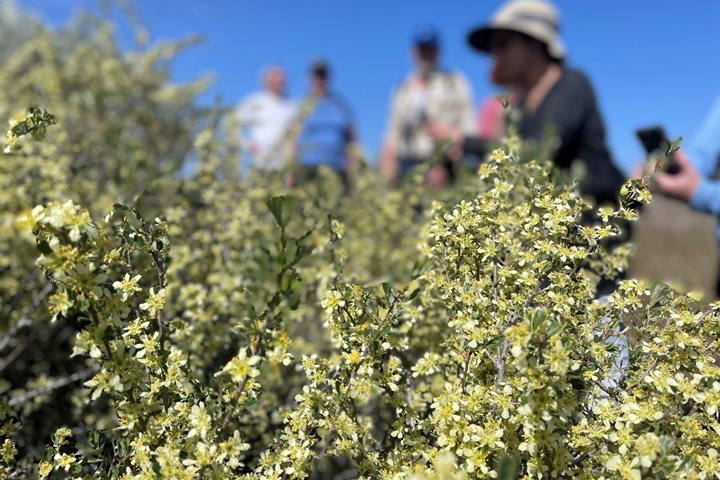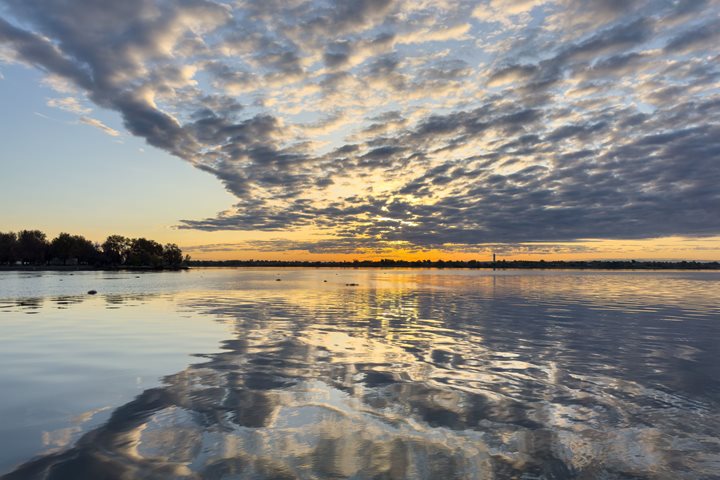At dawn the National Geographic Sea Bird approached Little Goose Dam on the Snake River. The weather was clear and mild and we locked through the dam at breakfast time. Soon Captain Kay was easing our ship into the mouth of the Palouse River and here we dropped anchor and prepared for our day’s activities. First those who were on their way to Palouse Falls boarded the expedition landing crafts and went ashore to meet a motor coach for the ride to the falls. A freight train was crossing the Joso High Bridge, a trestle popular internationally with railroad aficionados. It was built before WWI to shorten the journey from Spokane to the coast. We drove up to the Channeled Scablands, an area ravaged by the great Ice Age floods. Western meadowlarks flew up from the fields on either side of the road. Tumbleweeds, also known as Russian thistles, lined the road; they are not as romantic as old western songs would lead us to believe.
At Palouse Falls the Palouse River plummets over the lip of a basalt flow and drops 298 feet into its round, dark plunge pool. From here it winds its way south through the Palouse River Canyon. New interpretive signs provide excellent information on the area. We walked along the trails at the top of a cliff and took photos of this fine scene. Many sunflowers were still in bloom; American goldfinches fed on the seeds of the flowers that have finished and aromatic sagebrush and pastel-flowered buckwheat grew near the paths.
Our next adventure was an expedition landing craft tour of the lower Palouse River and the canyon. Pete and Gretchen, experienced Lindblad naturalists, met us here and they participated in the river cruises. We cruised upriver, making many stops to examine plants such as cattails, tule bulrushes (used extensively by the Nez Perce), and big sagebrush. Beautiful cliffs of layered basalt with intricate jointing features forming colonnades and entablatures rose above the river. Sumac bushes were crimson against the talus slopes. High above a red-tail hawk soared along the cliff face. A great blue heron sprang from the river’s edge and flew across to a low cliff where it perched and looked down at us.
In the afternoon we sailed back out onto the Snake River and enjoyed the scenery from the bow. The basalt formations along this stretch of the river are magnificent. When we came to Lower Monumental Dam and Lock many of us opted to go through the lock in the expedition landing crafts. It was great fun as we had time to take a little tour along the river shore before following National Geographic Sea Bird into the lock and tying up to a floating bollard. We dropped 99.5 feet from the level of the river above the lock to the level of the river below. Then, the expedition landing craft drove out of the lock ahead of our ship. Back on board we saw a film about the Ice Age Floods that ravaged this area; these were the largest floods known on Earth. This was followed later by information from Grace, our geologist, on the Columbia River Basalt Province. One of these basalt flows, the Grande Ronde member, is the largest known lava flow on Earth. So this is special country with a violent and interesting geological history.
Just at sunset we entered the Ice Harbor Dam Lock. Pastel colors of the sky were reflected in the glassy surface of the water. Then it was dinnertime so we joined our shipmates for a fine meal and friendly conversation. This busy and interesting day ended with a presentation by our expedition leader, Marylou, and naturalist/certified photo instructor, Rich (aka Mad Dog) on The Partnership of National Geographic and Lindblad Expeditions.









